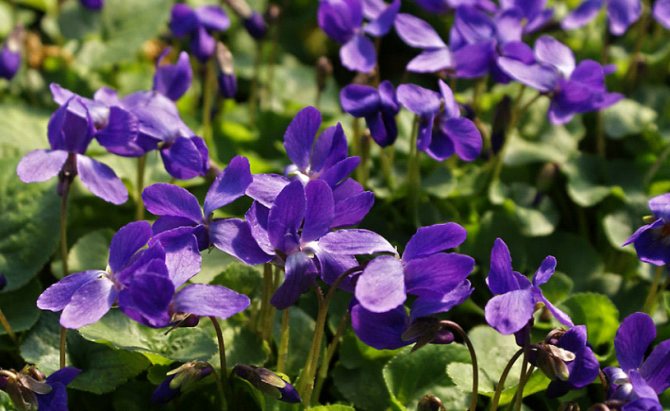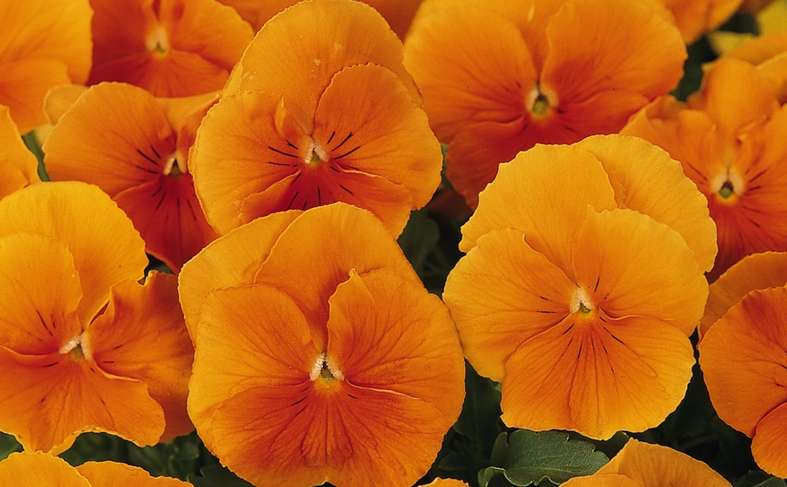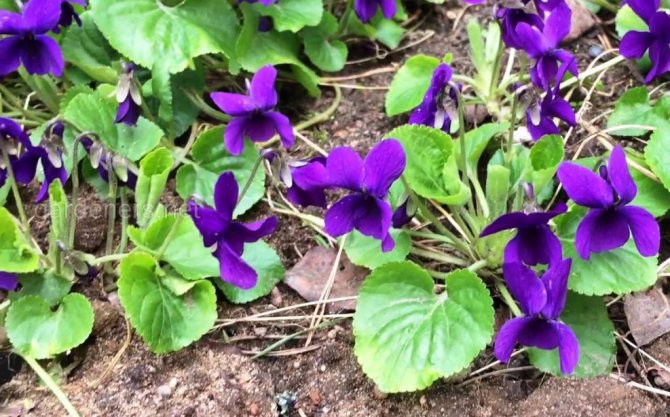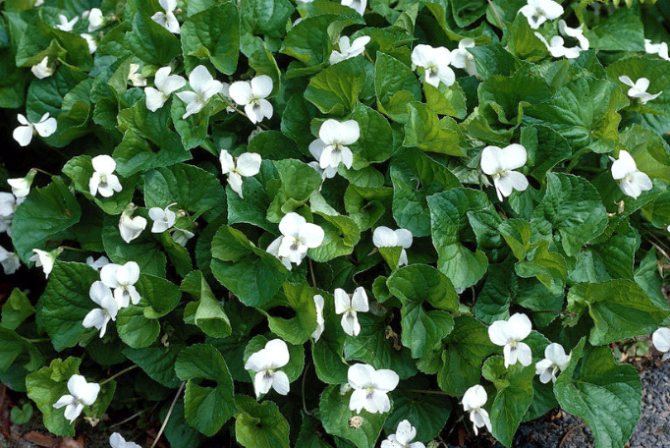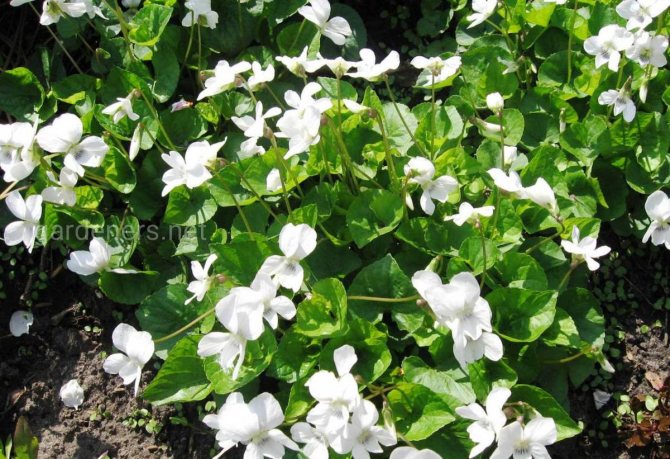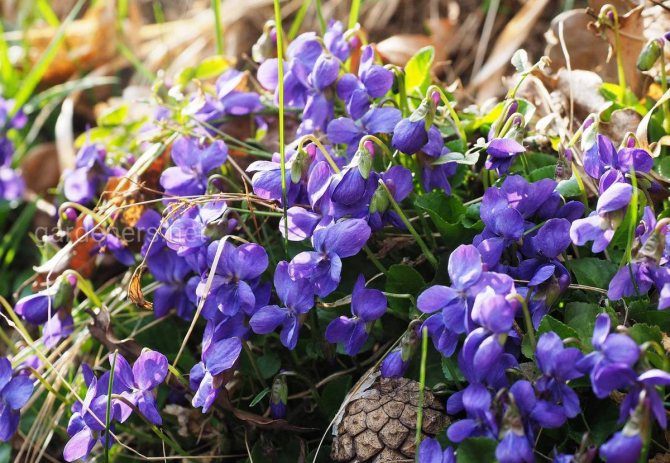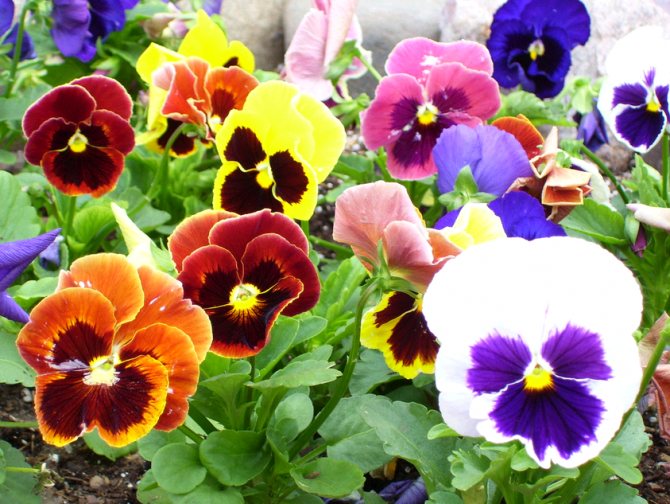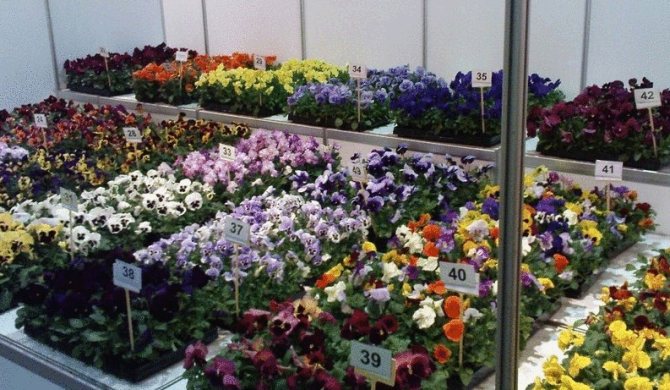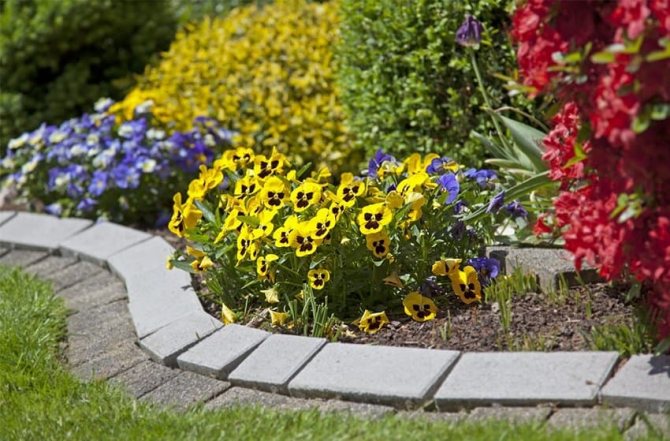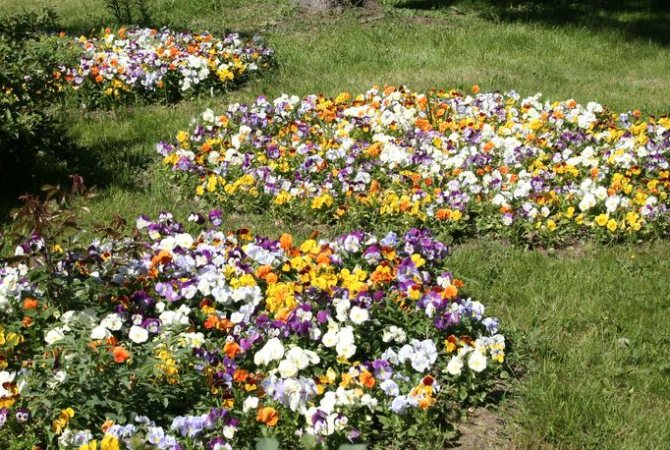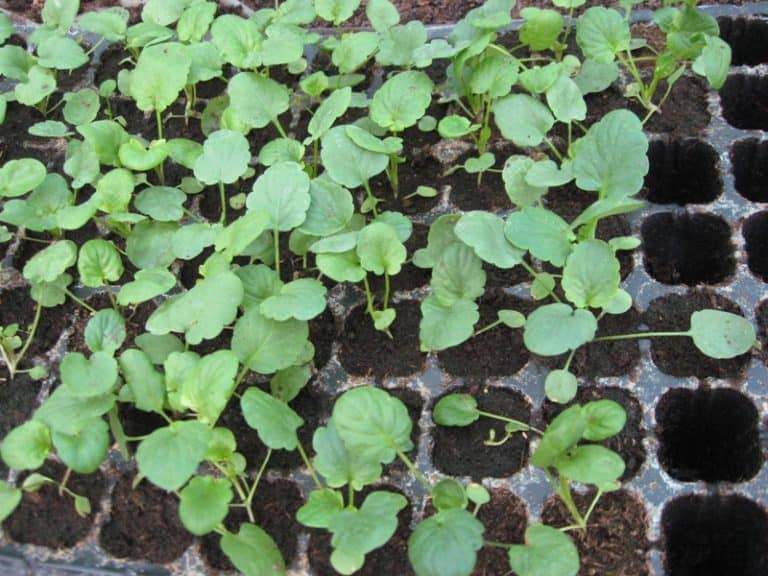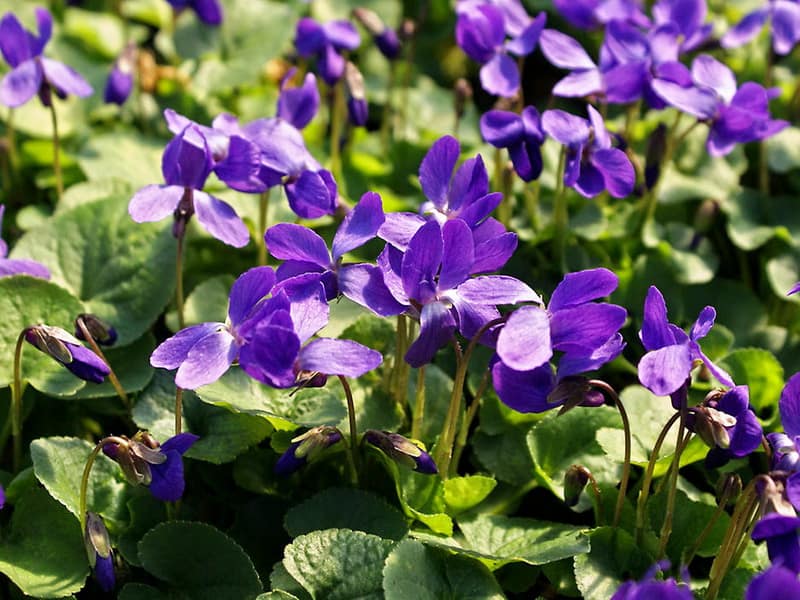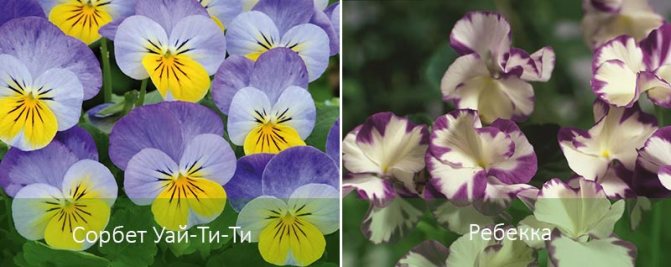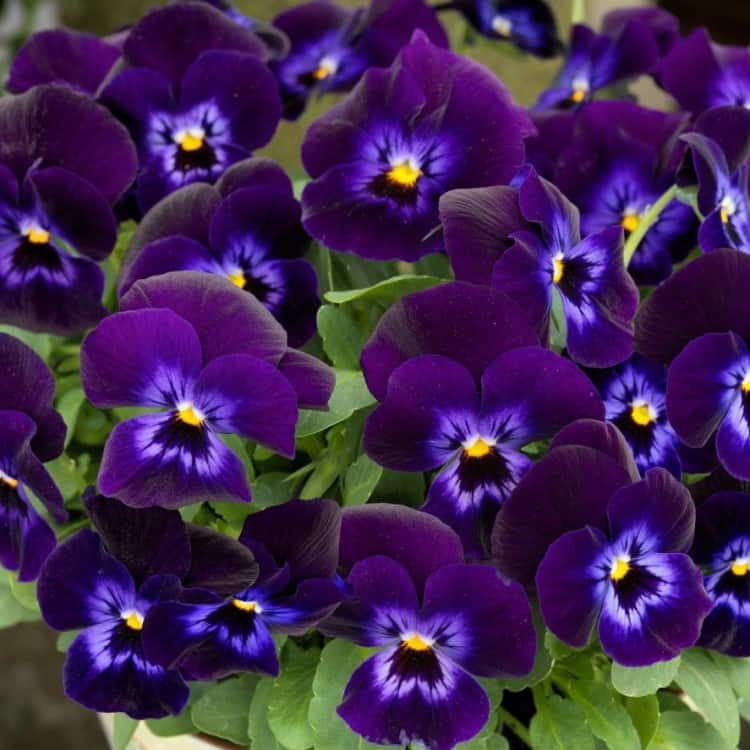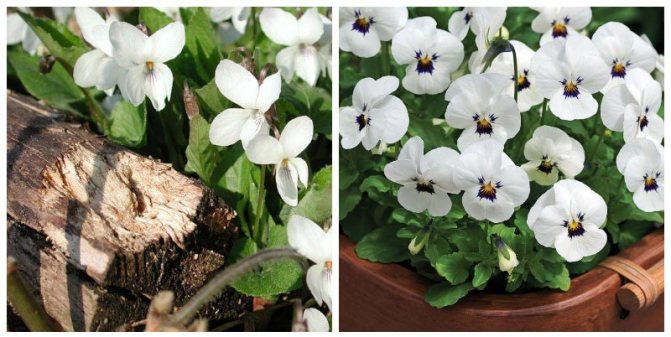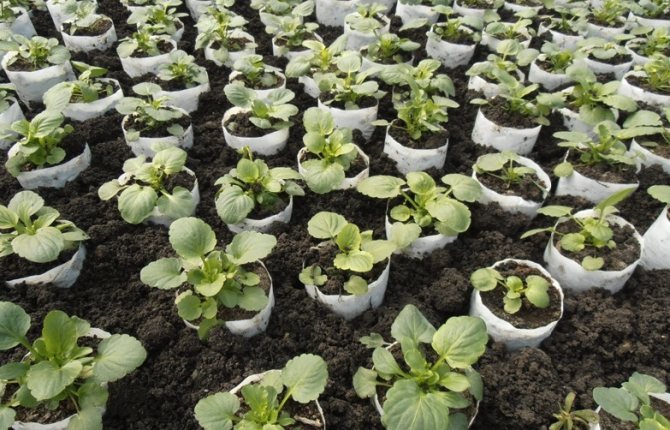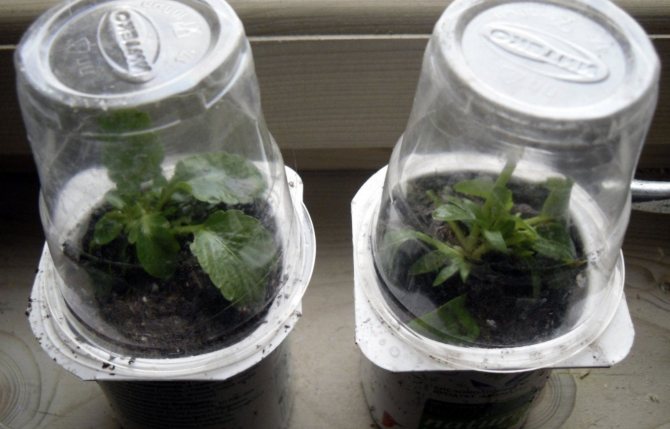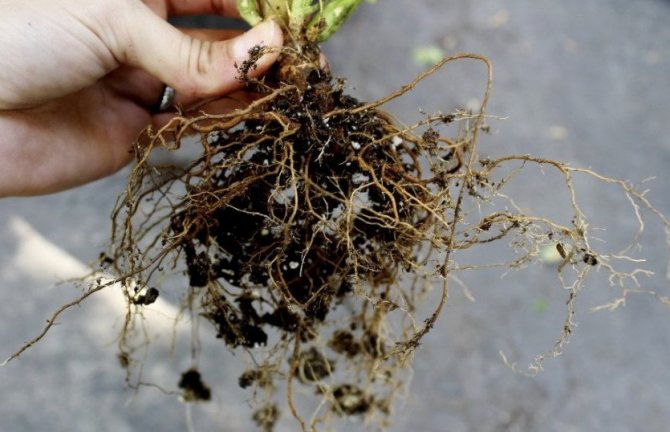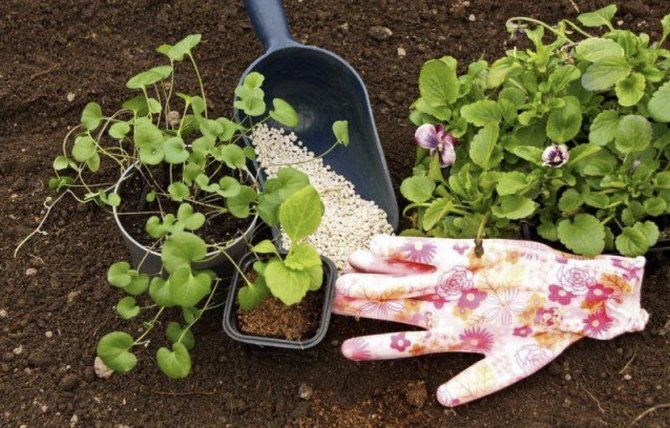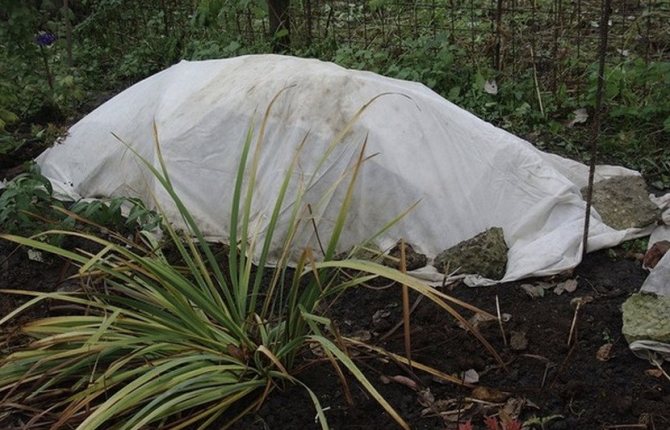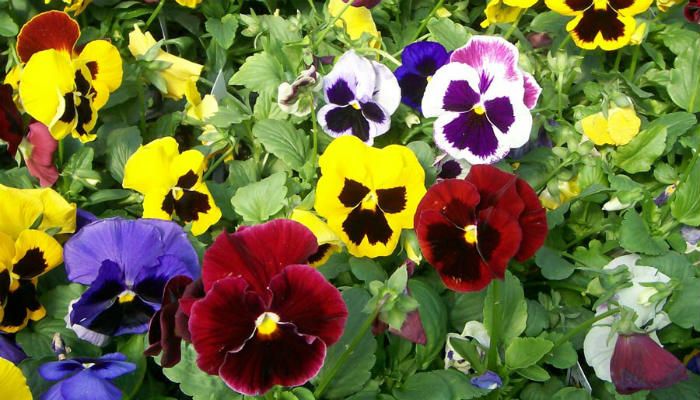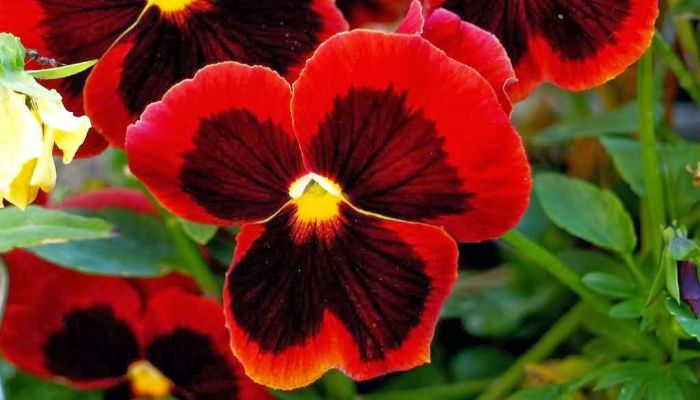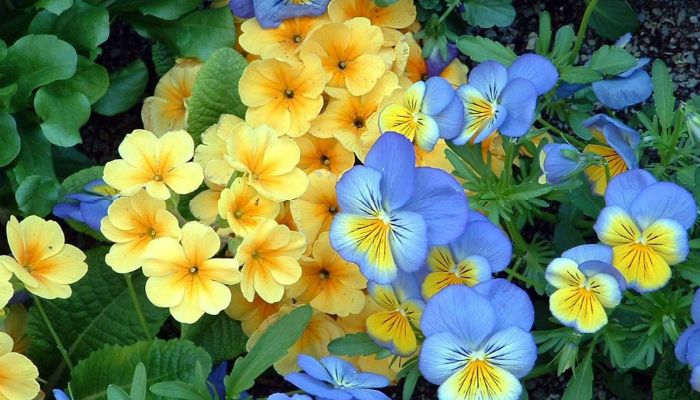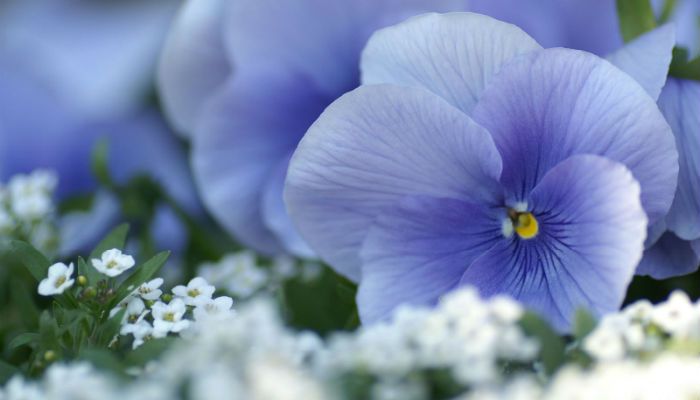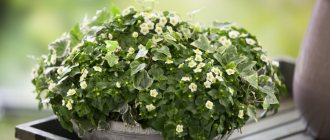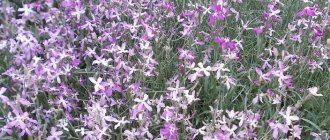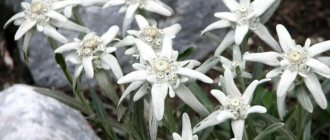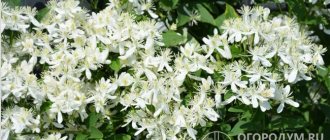The garden violet belongs to the genus Violet (Violaceae) and is a common plant in spring gardens around the world, where the miniature heart-shaped flowers are easily recognizable.
Violet is one of the oldest horticultural crops. About 2,400 years ago, the ancient Greeks and Romans decorated their premises with violets on holidays and at dinner parties.
These small plants, with characteristic elongated petals, are surprisingly hardy and strong.
Violets are often recommended for soil cover, as they grow well, forming large blooming clumps under bushes, especially roses, with which they work well.
Most of the violets grown in gardens are grown as annuals or perennials. Some species are self-sown and provide years of beauty enjoyment. Violets are primarily flowers of a cool climate. They bloom magnificently at the beginning and end of the season, and delight the eye with their dense, variegated islets of blue, white, yellow or multi-colored flowers. The flower size, compactness and long flowering period are ideal for container planting. Hanging varieties look elegant in hanging baskets and window containers. They are outstanding in bouquets and compositions.
Outdoors, violets create a beautiful edging along a walkway or define the boundaries of a garden.
Horned violet
The scientific name of this flower is Viola cornuta... It is this natural species that is most often implied when it comes to the horned violet.
He is a representative of the numerous violet family, which was introduced into culture in the second half of the 18th century.
general information
Under this name, both the perennial street violet (V. cornuta) and the varieties bred on its basis, as well as numerous hybrids... For a number of characteristics, they often differ significantly from the natural species, especially in terms of winter hardiness.
Varietal violets live in flower beds as perennials and withstand frosts down to -25 ℃, while hybrids are more susceptible to unfavorable conditions, their more often grown as annuals or biennials.
You can see a photo of a perennial horned violet on the right.
Growing in nature
Natural growing environment viola is a mountainous area of Spain and France.
Morphological description
Horned violet is a herbaceous perennial the Fialkov family. Depending on the variety, the bush grows up to 10-25 cm in height. Expanding, the stems intertwine and form dense cushions.
Leaves:
- Simple;
- Dark green color;
- Oval shape;
- Pointed.
Single flowers on a long stem, for them characterized by a delicate aroma... The diameter of the corolla depends on the variety and ranges from 2 to 5 cm.The color of the petals:
- White;
- Yellow;
- And the whole spectrum from blue to violet tones.
There is a bright yellow spot in the center of the flower. On the back of the whisk there is an elongated processhorn-like.
The fruit is a unilocular capsule.
Important! Some hybrid forms of the violet have no horned spur.
All varieties and hybrids derived from this species, have a number of advantages:
- A wide range of petals colors;
- Early onset of flowering, which begins in April-May;
- Long flowering - from May to September;
- Cold resistance;
- Persistent immunity to phytopathogens.
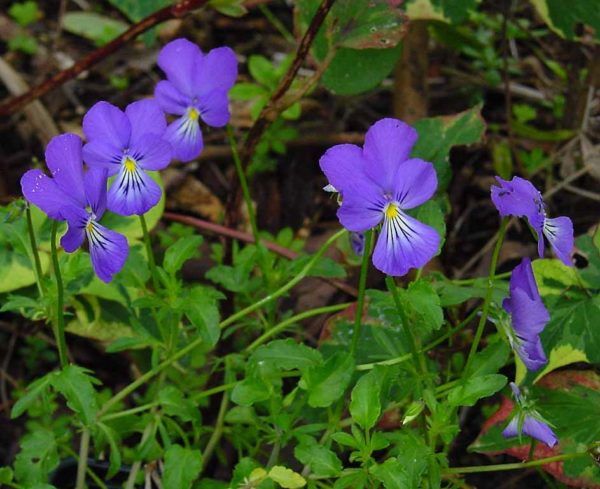
Horned violet hybrids have other advantages.
Garden forms presented simple and ampelous varieties.
Features of the root system
Plant has a branched rhizome - a modified underground stem, thanks to which it actively grows.
Just a few bushes in a year can form a dense cushion of 2 m2. Each can bear up to several dozen flowers.
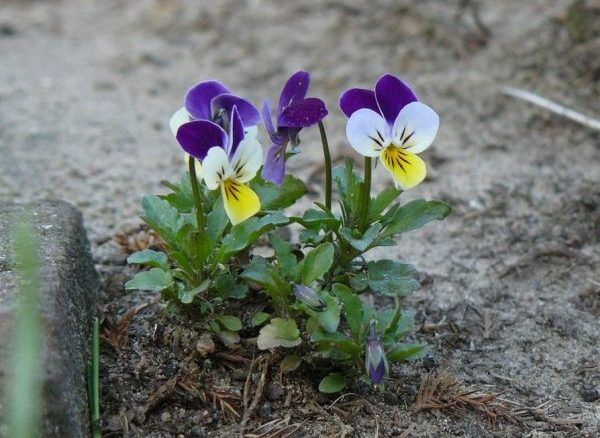

The roots of the horned violet are actively growing.
Rich choice
Gardeners must first decide how long the violet will decorate their flower bed. After that, you can choose an annual or biennial plant. However, more and more people are opting for perennial garden violets.
Their main advantage is that such plants will decorate the backyard for many years. But for the violets to feel comfortable, they need care. Then the flower bed will acquire a delicate, but at the same time bright color. Correctly selected types of violets will help with this.
Outdoor cultivation
Violet two-horned perennial quite unpretentious, but in order for her to feel good, it is necessary to create comfortable conditions for her.
How to choose a landing site?
Viola prefers moderate temperatures, therefore, it is better to plant it in partial shade or next to larger plants that can protect the violet from overheating.
Attention! Too much shading promotes moisture stagnation and can provoke slugs to attack violets.
In addition, the site must be well ventilated.
What soil does the plant prefer?
For abundant viola bloom the soil should be required quality:
- The most suitable is loamy, well-drained soil with an acidity of 6.5-7.2;
- To avoid stagnant water, you can prepare a substrate from a mixture of humus and loam;
- The surface of the soil is mulched with chips, tree bark, etc. to keep moisture.
Watering and feeding
Viola need to water well and feed a little, which is determined by the quality of the soil. The soil is fertilized no more than twice a year:
- In the spring, when the violet begins to grow, and at the end - after the end of flowering;
- It is optimal to use mineral or organic feeding containing a complex of microelements.
Important! The exception is fresh manure, it is destructive for violets.
Planting rejuvenation, pruning, decorative support
To maintain the flawless appearance of the flower bed, it is recommended every few years plant young violets... Such an update will go completely unnoticed.


To rejuvenate the bush, it is necessary to plant young shoots.
To maintain the beauty of the bushes at the end of the season remove peduncles with seed pods.
Preparation for wintering
The horned viola is characterized by high resistance to low temperatures... In many regions of Russia, she hibernates right in the flower bed. To do this, it is enough to place spruce branches or sawdust on top of the flowers.
Causes of diseases
Diseases can manifest themselves in the planting of garden violets only in case of violation of the agricultural technology of its cultivation. Therefore, in order to avoid the death of plants, the rules of planting and care should be followed.


When diseases appear, you should immediately take the necessary measures. The most common diseases of viola gardening:
- Powdery mildew, covers the plant with a gray or white bloom.
Reason: feeding only with nitrogenous fertilizers, abundant morning dew in a dry hot summer.
Control measures: treatment of the plant with a soap solution of soda ash, foundation, ground sulfur.
If necessary, the treatment is repeated after 10-15 days;
- Gray rot and black leg.
Reasons: violation of the temperature regime of the humidity of the surrounding air and soil.
Control measures: removal of diseased plants with subsequent treatment of the soil with foundation;
- Spotting, causes weakening of the plant, drying of leaves.
Control measures: to destroy an infection that is dangerous for the entire garden, diseased plants should be destroyed (burned). Treat healthy specimens with Bordeaux liquid. Repeat the procedure after two weeks;
The main pests of viola are the clover moth caterpillars and violet mother-of-pearl. The emerging pests are destroyed with tobacco infusion, chlorophos.
Features of growing from seeds at home
How is the cultivation of perennial horned violets from seeds? Reproduction of viola by seeds provides the plant with a large disease resistance.
Sowing seedlings
Violet seeds are sown for seedlings in February:
- A layer of drainage made of expanded clay or other materials is laid out on the bottom of the container, then a prepared earthen mixture;
- The substrate is disinfected with a freshly prepared hot solution of potassium permanganate (0.5 g is dissolved in a liter of water) and dried in air;
- Grooves are made with an interval of 1.5-2 cm and a depth of 0.3-0.4 cm, the seeds are laid out, covered with earth and watered; moistened by spraying;
- Greenhouse conditions are created, the film is slightly opened once a day for airing.
Important! After germination, the seedlings are placed in good light at an air temperature of up to 18 ° C.
What do seedlings look like?
Emerging sprouts have two rounded leaves on a thin stem. For 2 - 3 weeks, they should be shaded from bright sunlight.
Seedling care
Young violets are shaded and weeded, 12-14 days after rooting, you can to carry out mineral feeding.
Picking
After the formation of several pairs of real leaves, a pick is carried out - transfer to a permanent place.


There should be a distance between the violets when planting.
It is recommended to do this already in April, since the seedlings can withstand frost. The interval between violets is 5 cm.
Features of sowing in open ground
Sowing of seed is carried out in the period August 10-September 10:
- The earth is loosened, grooves are formed;
- Seeds are covered with earth, watered, mulched.
Seedlings will appear only next spring... If the sowing is too thick, a pick is carried out. You can start replanting them in August.
Seed germination
On a pack of seeds similarity is indicated, which can be from 60 to 95%. This should be taken into account when sowing. Outdoors, sprouts need traditional care.
Unconventional color
Most gardeners strive to fill the flower bed with plants, the flowers of which have a bright, rich color. Such a composition will undoubtedly attract attention, but it will quickly tire the eyes. The abundance of bright colors makes the overall picture too overloaded, and then the gaze is desperately looking for something more restrained.
White garden violet is a plant that is not as popular as the ones listed above, and is completely undeserved. With the help of this beauty, you can neatly and gently shade bright swatches. The snow-white color will look no less interesting and create contrast.
Such a violet can be found among representatives of different species: fragrant, horned, heel. It is enough to choose the desired flower shape and decorate the composition with it, and it will sparkle with new colors.
Vegetative propagation
Violets are easy to propagate by plant parts - vegetatively.
Dividing the bush
This method is used from early spring to half of summer, then the plant will have time to form the root system. before winter:
- The bush is removed from the ground and divided into several parts, each of which has roots;
- The separated violets are planted in a shaded place on moist soil.
Substrate moisture constantly monitored... It takes two to three weeks for rooting, but young violets are transplanted to a permanent place only in the spring of next year.
Layers
One of the most easy breeding methods violets:
- They choose a longer shoot on a bush, fold it back and attach it with brackets to the soil;
- The attachment points are sealed with soil, which is periodically moistened;
- Roots will develop on the fixed stem over the course of a month.
Important! After rooting, the cuttings are separated from the adult violet.
Cuttings
Violets are propagated by cuttings from June to mid-summer:
- The stem is cut into cuttings 5 cm long and several nodules;
- Each segment should have 3-4 leaves;
- Plants are rooted in a container with a substrate that is well moisturized;
- The stalk is inserted into the substrate at an angle to a depth of 1 cm;
- The pot is tightened with a film, creating greenhouse conditions, once a day, open for airing.
Soon after rooting, the plants will begin to grow, after wintering them transplanted to the site.
Care
Violets are unpretentious and, subject to the basic rules of care, will delight with abundant flowering throughout the summer.
In the spring, after germination or planting, shoots are recommended to be sprayed with a fungicide solution to prevent fungus.
Watering flowers should be moderate and regular. On 1 m², 10 liters of water should be poured weekly. In dry weather, the frequency is increased up to 2–3 times. Non-mulched soil must be loosened periodically.
Top dressing is required for plants 3-4 times during the growing season. Before laying the buds and for more abundant flowering, potassium-phosphorus mixtures are introduced; to increase the green mass immediately after the snow melts, nitrogen compounds are used. You cannot fertilize violets with fresh manure, they cannot stand it.
To preserve the decorative qualities of plants, it is required to regularly cut off drying shoots, withering flower stalks and fruit pods. Autumn self-seeding should not be allowed.


Varietal violets and hybrids
In the process of many years of selection, specialists brought out violets of different varieties... They steadily transmit parental traits when propagated by seeds or vegetatively.
Hybrids are obtained crossbreeding:
- Different varieties;
- Or hybrids among themselves.
Their offspring characteristics are stable only transfers:
- With vegetative propagation;
- With seed reproduction, the traits are not reproduced stably.
Important! To reproduce the color of hybrids, they are propagated only vegetatively.
Not all hybrid violets have a cornea, this trait is often suppressed by the genes of another violet species that participates in hybridization.
All representatives of the horned violet are perennials, but hybrid forms quickly lose their decorative effect, so they are grown for one or two years.
Varietal violets usually withstand severe frosts and without shelter, but in order to survive the winter for hybrids, they must be thrown:
- Dry leaves;
- Lapnik;
- Or other covering material.
Young violets even of frost-resistant varieties need shelter.
Bambini horned
The variety is winter hardy. Bush grows up to 15 cm in heightThe stems form dense cushions.
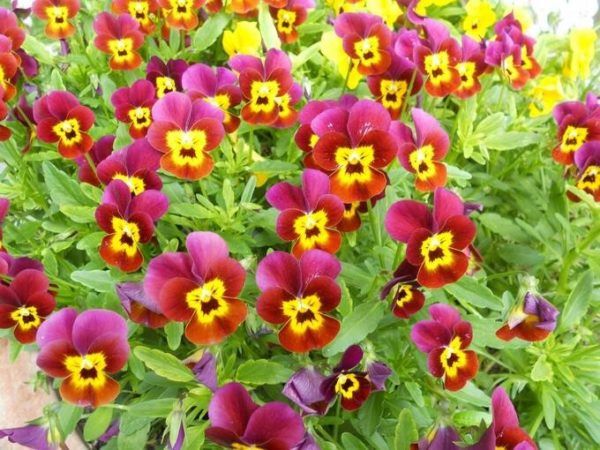

Violet Bambini horned.
The hybrid line is represented by flowers of various colors, but with a mandatory yellow spot in the center and a contrasting pattern in the form of a fantastic muzzle.
Button blue
Plant height about 20 cm... Flowers 3-5 cm in diameter, pale blue color and light aroma.
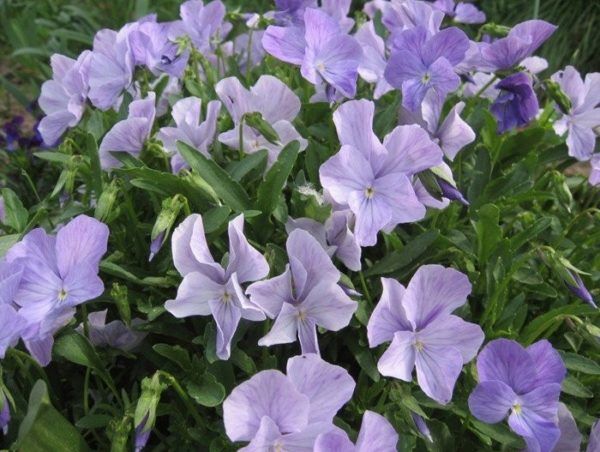

Violet Button Blue.
Lady horned
The height of the bush is 10 cm. The stems are intertwined in dense cushions. The flowers are tricolor, purple-lavender with a yellow lower petal.
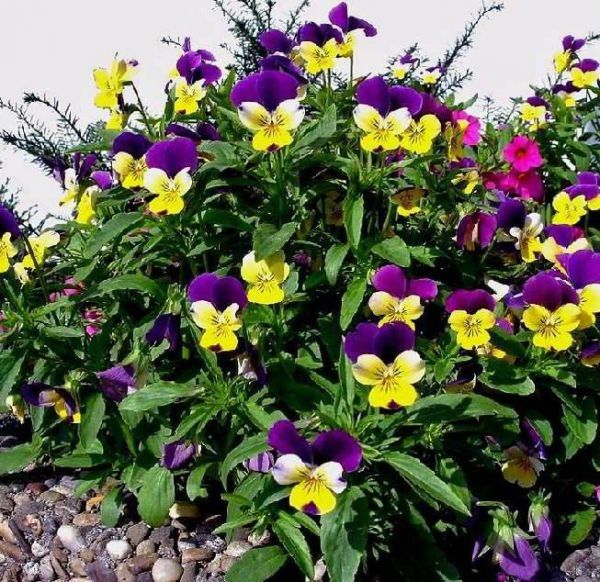

Violet Lady horned.
Abundant flowering, the bush can bear up to 50 flowers.
Gzhel patterns
The color of the white-blue flowers similar to Gzhel painting... Bushes reach a height of 15-20 cm. The stems grow into dense cushions.


Violet Gzhel patterns.
Baby
Bushes grow up to 10 cm in height, stems form thick cushions... The varietal line is represented by white or blue-violet flowers.
Violet Baby.
The bush can bear several dozen flowers at the same time.
Fashionista
The height of the bushes is about 15 cm, the varietal line is presented flowers of yellow and blue color.
Violet Fashionista.
Ruby perfection
Flowers of medium size, rounded, bright ruby color, in the center blurry dark spot... The stems grow into thick cushions.
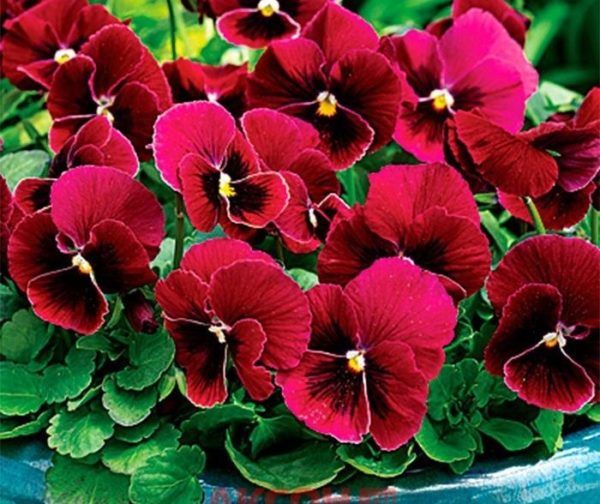

Violet Ruby perfection.
Tiger Eye Red
Flowers with a unique veined color and early abundant flowering.


Violet Tiger Eye Red.
Scottish (Scotland)
This hybrid line can have the most varied colors.
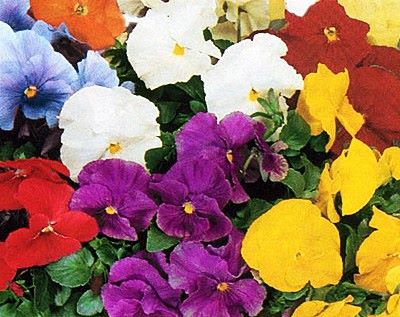

Violet Scottish.
Orange Parple Wing
Flowers with:
- Bright orange lower petals;
- Purple streaks in the center;
- Spots around the edges.
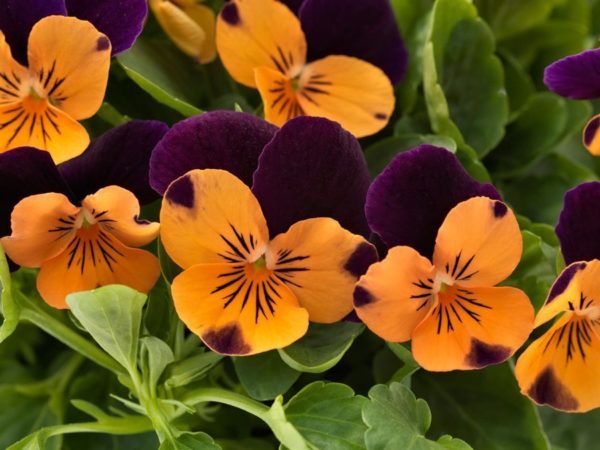

Violet Orange Parple Wing.
A pair of top petals - dark purple.
Captivating scent
A fragrant violet can boast of such dignity as a strong aroma. She will fill the garden not only with external beauty, but also with tangible ones.
It is a perennial plant that has massive roots and shoots that creep along the ground. Leaf length - 9 cm, width - 8 cm. It is subdivided into a number of varieties, which affects their shape. Mostly it is rounded, sometimes more rounded specimens are found, the petals can have both pointed and curved edges. The color of the flowers is purple. Stipules broadly lanceolate and slightly pointed.


The flowering period is from the end of summer and throughout the fall. Fragrant violet has many interesting varieties that will satisfy the needs of any gardener. Those who prefer a particularly large flower size should choose Triumph. Lovers of a pronounced aroma should give preference to the Czar variety. The intricate shape of a flying bird and a fragrant scent is the Rosina violet.
Use in landscape design
A plant is planted in a group so that they bloom created a feeling of celebration.
Violets look unsurpassed next to an evergreen shrubas well as on the front line of flower beds. Viola grown in pots and pots is a decoration of a home veranda or balcony.
Violets are good adjacent to most garden plants. But it is better not to plant them next to lilies of the valley or sweet peas.


Horned violet in landscape design.
Where to plant
Violets love sunlight, but can grow in slightly shaded areas. Delicate and graceful elegant corollas look very romantic and add sophistication to the garden. Low-growing varieties will look great on lawns, between low bushes, in open flowerpots, as a framing of paths, decorating stone hills, balconies. Tall varieties are suitable for the central areas of flower beds. You should not hide violets under the dense crowns of trees, there they quickly grind and wither.
Pests
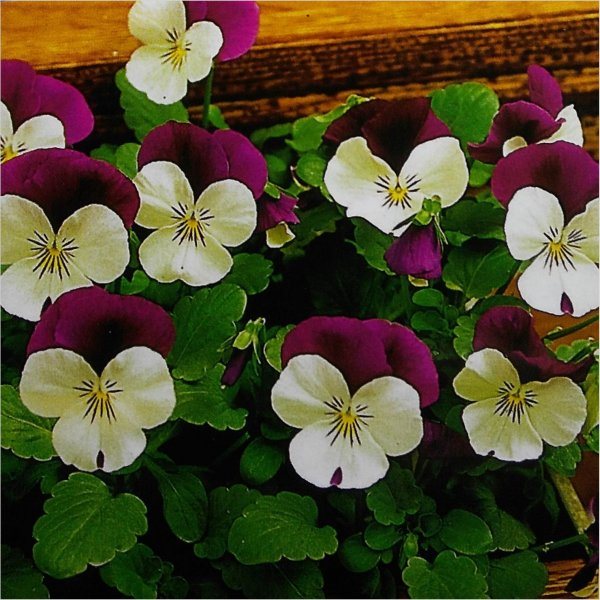

Violets are not susceptible to disease, and therefore rarely cause trouble for gardeners. If suddenly the plant does not bloom or withers, then, most likely, the cause is unfavorable conditions or improper care:
- Lack of light can cause slugs to appear on the bushes. You can get rid of them by spraying with ammonia solution (25%).
- Brown spots on foliage can appear from cold watering. Violets love room temperature water.
- Yellow spots on foliage appear when watering in the hot part of the day under the scorching sun. To avoid scalding, it is recommended to moisten the soil early in the morning or in the evening.
- If the greens have lost their elasticity and looks dusty, then the reason most likely lies in the decay of the root system. This situation is possible with an excess of moisture.
- Incorrect application of complex fertilizers or a sharp change in weather conditions can lead to the fall of all the buds.
Exquisite blue
The blue garden violet is a classic of sorts. This is one of the most popular colors used by gardeners when creating alpine slides, flower beds, borders.
The combination of blue and purple looks especially interesting. They complement each other, creating interesting transitions and enhancing color depth. Blue violets can be found in almost any form, but pansies are the most popular choice. In them, the combination of dark petals with light ones appears in an unusual contrast, which makes it possible to use one flower in flower beds with a small area.
Planting biennial crops
Large-flowered hybrid forms are grown as biennial plants. Seeds are sown in the second half of June. For this, containers with a substrate are used. Growing in greenhouses or hotbeds is also possible.
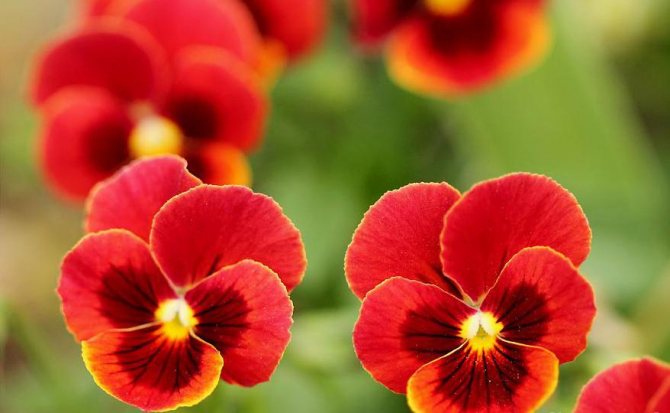

The soil temperature should not be higher than +20 ˚С, otherwise the germination of seeds will be low. It is for this reason that it is preferable to sow them in containers rather than in open soil. The first shoots appear in a couple of weeks. Young plants must be shaded from direct sunlight, loosened and watered.
Motley lady
Among the wide variety of types of garden violets, one cannot fail to note the Vittrock violet, or Rococo. Such an unusual representative was obtained by crossing not two, but three species - yellow, tricolor and Altai.
The variety also belongs to perennials, but is more often used as a biennial.
The stem reaches a length of 40 cm, branched. The leaves are ovoid. But the real interest is, of course, the flowers themselves. They are quite large - 7 cm in diameter. The color depends on the variety. There are so many of them that experts had to divide them into variety groups, taking the diameter of the flower as a selection criterion.


One of the most famous is Rococo. Its flowers reach 8 cm in diameter. The petals are terry, which makes the violet even more lush. The color is the most diverse: the dark spots characteristic of the tricolor look look great on yellow, purple, snow-white, lilac petals.
For aesthetes and lovers of everything unusual, the Morenking variety was created, the flowers of which are painted black.
Night beauty
The garden night violet deserves special attention. The plant is perennial. The stem is high, straight. Its length can reach 80 cm. The upper part is branched. The leaves are pointed, slightly toothed, glabrous.
The flowers are small, but they look magnificent due to the fact that they are collected in cylindrical brushes. The color of the petals corresponds to the palette of slowly approaching twilight - white, lilac, violet.
This species does not need difficult maintenance, it is resistant to cold weather. The night violet is often planted near benches or gazebos, because with the onset of evening, the flowers bloom, filling the air with a strong and pleasant smell.
Sunny mood
Another type of garden violet is yellow. Its stem is erect or ascending, up to 20 cm high. In Europe it can be found in the wild, but in Russia it is found only as an element of flower arrangements.
The shape of the leaves of the violet is oblong, with crenate edges. The flowers are small, about 3 cm in diameter. They have a bright yellow color with dark markings on the lower petals.
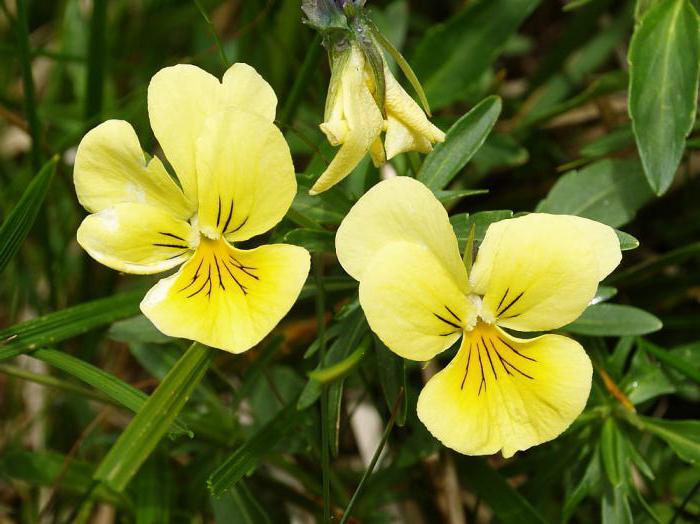

Violet begins to bloom in late spring - early summer. Has a pleasant aroma. Perfect for inexperienced growers, since it is an unpretentious plant and tolerates wintering well.
What do we know from history
There are many interesting stories around the horned violet. For example, in France this flower is considered a symbol of death, while in Germany it is associated with an evil stepmother. The most interesting legend about the appearance of beautiful flowers among the Slavs is that a girl from a poor family named Anyuta fell in love with a rich guy. They were not together for long.Almost before the wedding, the guy changed his mind about getting married. Anyuta cried a lot and, unable to bear the separation, died. After the funeral, after a while flowers of unusual beauty bloomed on her grave. They were called by the people - "Pansies". Despite all the sad legends, people all over the world grow violets at home and admire their beauty.




